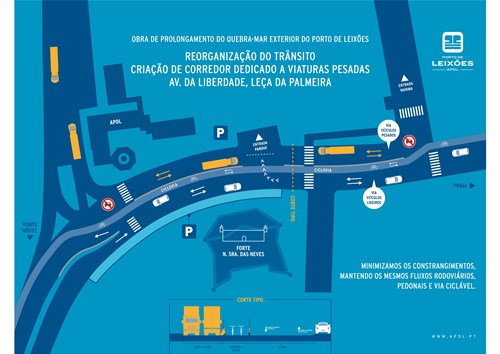Extension of the Outer Breakwater of the Port of Leixões,
Deepening of the Access Channel and Turning Basin
To ensure the competitiveness of the Port of Leixões, it is crucial to address the increasing average size of the ships calling at the port, which has seen a 77% growth between 2006 and 2018.
The objective of the project for the Extension of the Breakwater and Improvement of Maritime Accessibility to the Port of Leixões is to enhance safety conditions and navigability in accessing the Port of Leixões and in the ship maneuvering zone in the harbor approach.
The improvement will serve current maritime traffic, allowing for safer and more facilitated accessibility and maneuverability, thereby enhancing the overall port's operability. Additionally, it will create conditions for the access and reception of larger cargo vessels, particularly those of the class measuring 300 meters in length, 40 meters in beam, and 13.7 meters in draught, with a capacity of around 5,000 TEUs.

Therefore, after all studies, execution projects, environmental impact assessments, and obtaining the respective Environmental Impact Statements (EIS), APDL launches the tender for the Extension of the Outer Breakwater and Improvement of Maritime Accessibility to the Port of Leixões, with an estimated total value of 147 million euros.
This public investment will be the subject of a single contract, although it has been submitted to applications for different European Union funding:
Extension of the Outer Breakwater of the Port of Leixões by 300 meters with changes to its slope, with an investment value of 60 million euros and an approved EU contribution of 31 million euros, under the COMPETE 2020 program;
Improvement of Maritime Accessibility to the Port of Leixões through the Deepening of the Entry Channel from -15 meters/-12 meters to -16.85 meters and the Turning Basin of the Port of Leixões from -12 meters to depths of -15.5 meters, with an investment value of 87 million euros and an approved EU contribution of 17.4 million euros, under the CEF – Connecting Europe Facility – Transport Blending program.
The Port of Leixões is a port within the main network of the Trans-European Transport Networks, included in the Atlantic Corridor, which directly serves its hinterland, making it a strategic gateway port for the national economy due to the multimodal transport solutions it offers to businesses.
In this regard, this investment, included in Council of Ministers Resolution No. 175/2017, published in the Official Gazette, 1st Series, No. 227, of November 24, which approved the Strategy for Increasing the Competitiveness of the Main Commercial Ports Network of the Mainland - Horizon 2026, is of utmost importance given the significant growth in the size of ships at the Port of Leixões in all market segments, the imperative need to ensure adequate safety conditions, and promote port development in the context of new market trends.
This public investment enables private investment in a New Terminal next to the South Breakwater of the Port of Leixões, with depths of -14.8 meters, a quay line of 360 meters, a support land area of over 16 hectares, and a capacity of 435 thousand TEUs.
In the context of this investment in the New Terminal, APDL will also promote the improvement of operating conditions at the fishing port of the Port of Leixões, through the creation of a new cold storage warehouse, the establishment of a new ice factory, the upgrading of the retaining quays to be maintained, and the creation of a new quay line for the berthing of fishing vessels, generating a new sheltered port.
It is expected that the overall project (public and private investment in the new Terminal) will generate a net present economic value of 180.5 million euros, savings in transportation costs of goods along the logistics chain of 115 million euros, and positive environmental externalities of 50 million euros.
This New Terminal, together with the investment in the Conversion of the South Container Terminal of the Port of Leixões, being carried out by the concessionaire TCL - Leixões Container Terminal / Yilport Leixões, will increase the port's capacity to handle containerized cargo traffic to around 1.2 million TEUs per year and meet the demand for larger vessels.
Environmental Impact Assessment
Reports
The sediments are always subjected to rigorous prior analysis, particularly during the Environmental Impact Assessment. Additionally, APDL conducts periodic sediment samplings at the dredging sites, which are analyzed in compliance with current legislation. The analyses consistently yield results classifying the sediments as clean dredged material (class 1 or 2), ensuring the good quality of sediments for beach nourishment or immersion in water bodies along the coastal area of the Porto Metropolitan Area.

Detailed descriptions of the sediment collection and analysis campaigns can be found in the following reports:
You can also refer to the water analysis report collected on November 10th during the sediment discharge operations by rainbowing near Cheese Castle.










